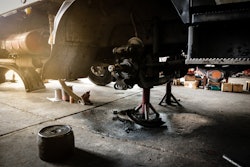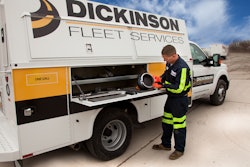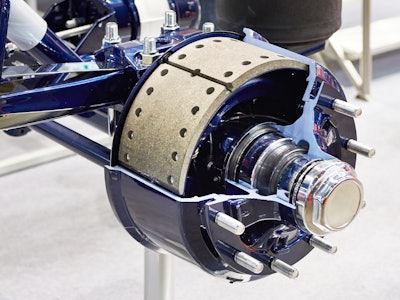
The following was published in CCJ's Equipment Maintenance Toolkit, 8th edition, sponsored by Valvoline Heavy Duty. CCJ's Equipment Maintenance Toolkit is a complementary industry resource, courtesy of our partnership with Valvoline Heavy Duty. You can download the entire Toolkit here.
A properly functioning wheel-end hub is essential to all medium- and heavy-duty truck and trailer brake systems. Which means when a hub begins to leak, the outcome if untreated can quickly become catastrophic.
As such, industry manufacturers advise hubs be checked regularly as part of any preventive maintenance procedure.
Hendrickson says hub assemblies are filled with lubricant during production. On the inboard side, lubricant is contained in the hub by the hub seal. Hendrickson states this is where leaks will most commonly occur.
"Major leaks can be obvious, as it will cause lubricant to coat brake surfaces and the inside of the wheel assemblies," Hendrickson states.
But oil seals are not the only root causes of leaks, SKF adds. "If you look, you will find that leaking wheel ends leave clues pointing to which component or components are the culprits," the company states, adding sometimes a tech "may find that just changing the seal may not be your permanent solution."
Manufacturers state when a leak is uncovered or appears likely, a technician should begin a service event by shutting down the vehicle, chocking the wheels and supporting the vehicle on stands. Hendrickson states to remove the dust shield inspection grommets to inspect brake linings for oil and grease. The company says with smaller leaks, technicians also will be required to perform a complete removal of the brake dust shields for proper inspection.
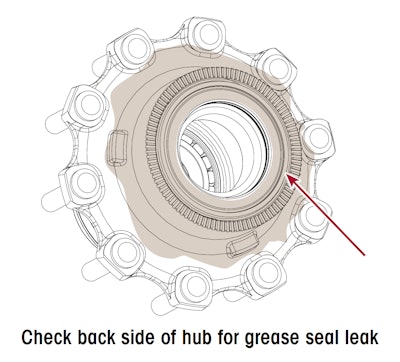 Hendrickson
Hendrickson
When disassembling a wheel end, SKF states that technicians should check the condition of hubcap, flange, window and centerfill plug. They also should check bolts and axle flange area on drive axle. After removing the hubcap, the company adds techs should check the condition of the lubricant.
SKF states cloudy or milky lubricant indicates water in the system, shiny indicates bearing wear, metal flakes present could indicate loose shavings from an axle component, grit and sand indicates lube contamination, and burnt smells indicates overheating.
Next, SKF indicates techs should check the condition of the fastening system, then remove the outer bearing and inspect it for signs of damage. A hub assembly spindle can then be evaluated to look for thread and chamfer damage, and the bearings should be set aside for further separate inspection, SKF notes.
To check for leaks, Hendrickson advises technicians to look at the inboard side of the hub. "A small amount of lubricant may be visible at the hub seal. This is a normal occurrence and does not indicate a seal leak," the company says. Lubricant also may be uncovered at the spindle bearing shoulder to hub joint, which also does not guarantee a seal leak. Hendrickson this area should be wiped clean post inspection to remove dirt and other contaminants.
STEMCO confirms that not all visible lubricant equates to a leak.
"We often see this in new seals that we test every day," the company says. "This seepage is most likely a result of grease pre]lube escaping from a newly installed seal. Our factory places this grease pre-lube into the seal upon assembly to reduce the frictional heat generation upon seal 'run-in.' If the visible seepage extends well out onto the hub and is quite damp, then the seal may be leaking and should be replaced at the first opportunity."
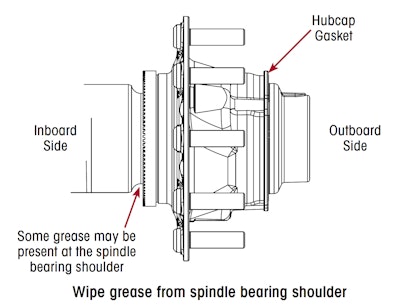 Hendrickson
Hendrickson
"If a hub seal is leaking, a large quantity of lubricant will be present," Hendrickson states. "Oil or grease may be spattered on the dust shield, brake shoes or brake drum. If this is the case, the seal and other components will need to be replaced."
Another thing to look at is the proper venting of the wheel end, STEMCO says. All wheel ends generate heat and when this occurs it will result in pressure in the wheel end, the company says. "If this pressure has no way to vent through the hubcap vent or axle vent then the wheel seal is likely to start leaking due to the excessive amount of pressure."
SKF adds that when inspecting the hub, technicians also should check for broken fasteners and bolts, cracks in the hub housing, damage to hub and bore. "If the bearing cup is loose in the hub, this indicates a serious condition and the hub must be replaced," the company says.


